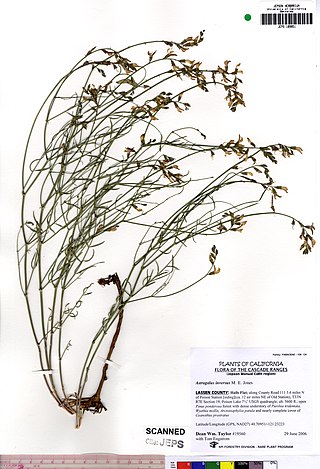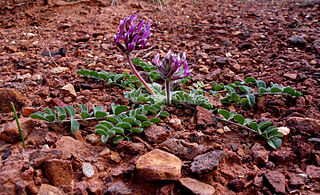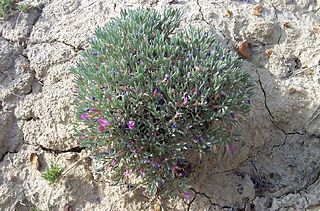
Astragalus agnicidus is a rare species of milkvetch known by the common name Humboldt County milkvetch. It is endemic to northern California, where it is known only from two populations in Humboldt County and one in Mendocino County.

Astragalus albens is a species of milkvetch known by the common names Cushenbury milkvetch and silvery-white milkvetch.
Astragalus austiniae is a species of milkvetch known by the common name Austin's milkvetch. It is native to the Sierra Nevada of California and Nevada in the vicinity of Lake Tahoe. It is a plant of the alpine climate of the high mountains, where it tolerates exposed areas.

Astragalus bicristatus is a species of milkvetch known by the common names crested milkvetch and two-crested milkvetch. It is endemic to southern California, where it grows in the coniferous forests of the San Gabriel and San Bernardino Mountains of the Transverse Ranges.

Astragalus brauntonii is a rare species of milkvetch known by the common name Braunton's milkvetch. It is endemic to California, where it is known from fewer than 20 extant occurrences in the hills and mountains surrounding the Los Angeles Basin in Southern California. This is a federally listed endangered species in the United States.

Astragalus congdonii is a species of milkvetch known by the common name Congdon's milkvetch. It is a perennial herb that is endemic to central California.

Astragalus inversus is a species of milkvetch known by the common name Susanville milkvetch.

Astragalus oxyphysus is a species of milkvetch known by the common name Diablo milkvetch. It is endemic to central California, where it grows in dry grassland and scrub habitat in the Central Valley and the adjacent Inner Coast Ranges and Sierra Nevada foothills.

Astragalus purshii is a species of milkvetch known by the common names woollypod milkvetch and Pursh's milkvetch.

Astragalus pycnostachyus is a species of milkvetch known by the common name marsh milkvetch. It is endemic to the coastline of California, where it grows in wet saline habitat such as marshes.

Astragalus cremnophylax is a rare species of milkvetch known by the common names sentry milkvetch and cliff milkvetch. It is endemic to Arizona, where the three varieties grow in three separate locations. The rarest variety, var. cremnophylax, is a federally listed endangered species which grows only on the rim of the Grand Canyon. The two other varieties are known from the Buckskin Mountains and Marble Canyon.

Astragalus holmgreniorum is a rare species of milkvetch known by the common names Holmgren milk-vetch and paradox milk-vetch. It is native to a tiny section of desert shrub woodland on the border between Utah and Arizona, in the far northern Mojave Desert. There are six populations remaining. It is a federally listed endangered species.
Astragalus humillimus is a rare species of milkvetch known by the common name Mancos milkvetch. It is native to a small section of the Four Corners region of the United States, where it can be found in Montezuma County, Colorado, and San Juan County, New Mexico. There are about nine small, localized populations on sandstone rimrock ledges on the mesas. The plant occurs in a region that is being developed for oil and gas exploration, and altered by associated activities such as road construction and pipeline installation. It is a federally listed endangered species.

Astragalus limnocharis var. montii, synonym Astragalus montii, is a rare variety of flowering plant in the legume family. It is known by the common name Monti's milkvetch. It is endemic to Utah in the United States, where there are only three known populations. Under the synonym A. montii, it is a federally listed threatened species of the United States.

Astragalus barrii is a species of flowering plant in the legume family known by the common name Barr's milkvetch. It is native to the United States, where it is a "regional endemic", occurring in parts of southwestern South Dakota, northeastern Wyoming, southeastern Montana, and Nebraska.
Astragalus tyghensis is a species of flowering plant in the legume family known by the common name Tygh Valley milkvetch. It is endemic to Oregon in the United States, where it is known only from the Tygh Valley of Wasco County.
Astragalus anisus is a species of flowering plant in the legume family known by the common name Gunnison milkvetch. It is endemic to Colorado in the United States, where it is limited to the Gunnison Basin of Gunnison and Saguache Counties.
Astragalus leptaleus is a species of flowering plant in the legume family known by the common name park milkvetch. It is native to the Rocky Mountains of the United States, where it occurs in Idaho, Montana, Wyoming, and Colorado.
Astragalus proximus is a species of flowering plant in the legume family known by the common name Aztec milkvetch. It is native to southern Colorado and northern New Mexico in the United States.
Astragalus wetherillii is a species of flowering plant in the legume family known by the common name Wetherill's milkvetch. It is native to Colorado and Utah in the United States.

















